This post may contain affiliate links. Please read our disclosure policy.
Homemade basil pesto, aka pesto alle Genovese – a green basil pesto sauce made with basil, pecorino, Parmigiano-Reggiano, pine nuts, garlic, and salt! This fresh pesto sauce is perfect for breads, pasta, salads, pizza, and more!
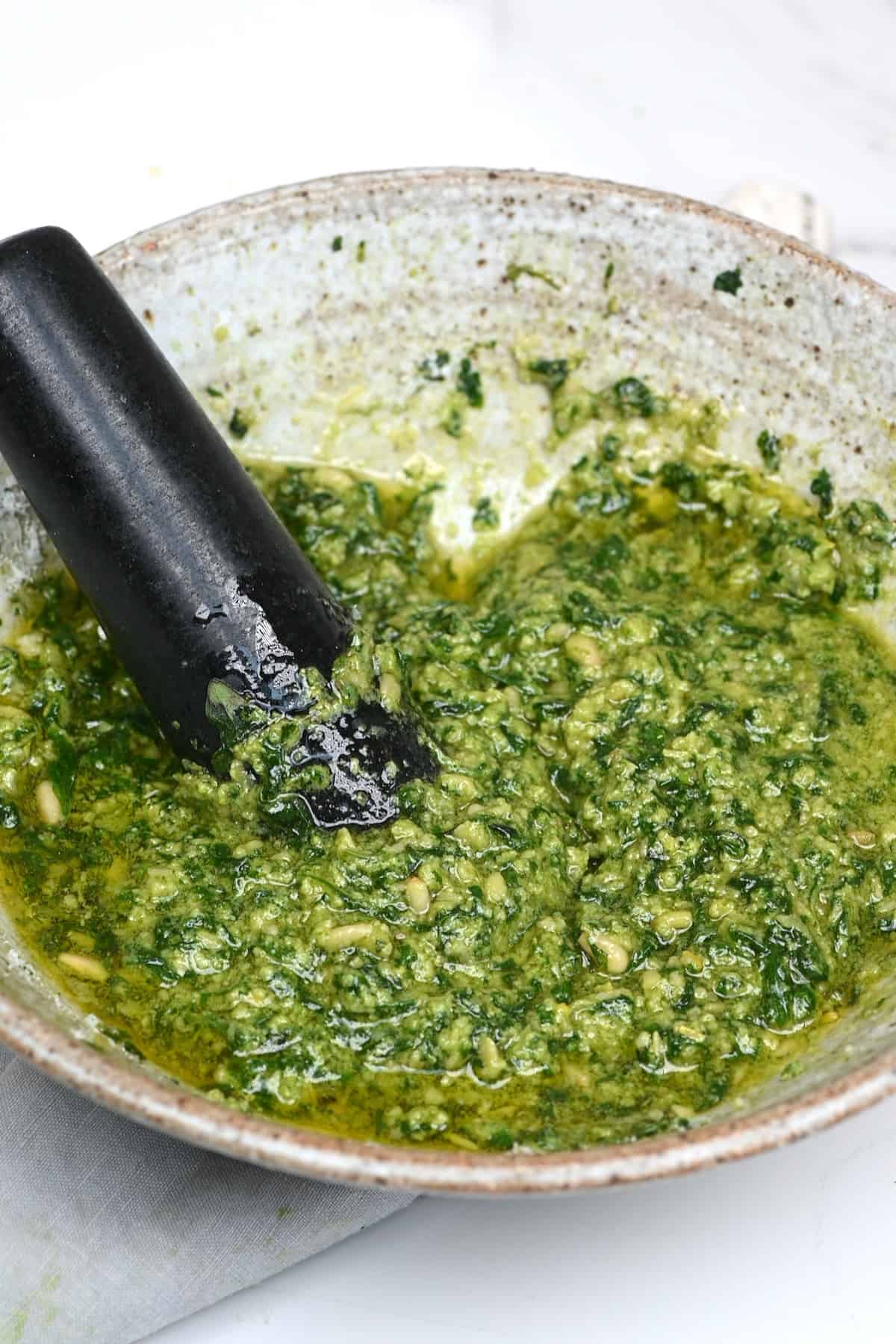
When it comes to homemade pesto, I’ve tried several, including this 5-minute arugula pesto, vegan basil pesto, and carrot top pesto. However, quite shamefully, I’d always used a “cheat” option of chucking everything into a food processor, and voila – pesto. What I’d never tried (before now) was making a classic homemade basil pesto (otherwise known as pesto alle Genovese) the traditional way, with a mortar and pestle. The results were what I can only describe as the best homemade pesto I’ve ever had in my life!
And, okay, if you have a food processor, then, sure, you can still do things the quick way. I won’t judge you (I’ve even included my method below!). However, advice from foodie to foodie, give the traditional way a try at least once before you whip out your food processor. You won’t be sorry!
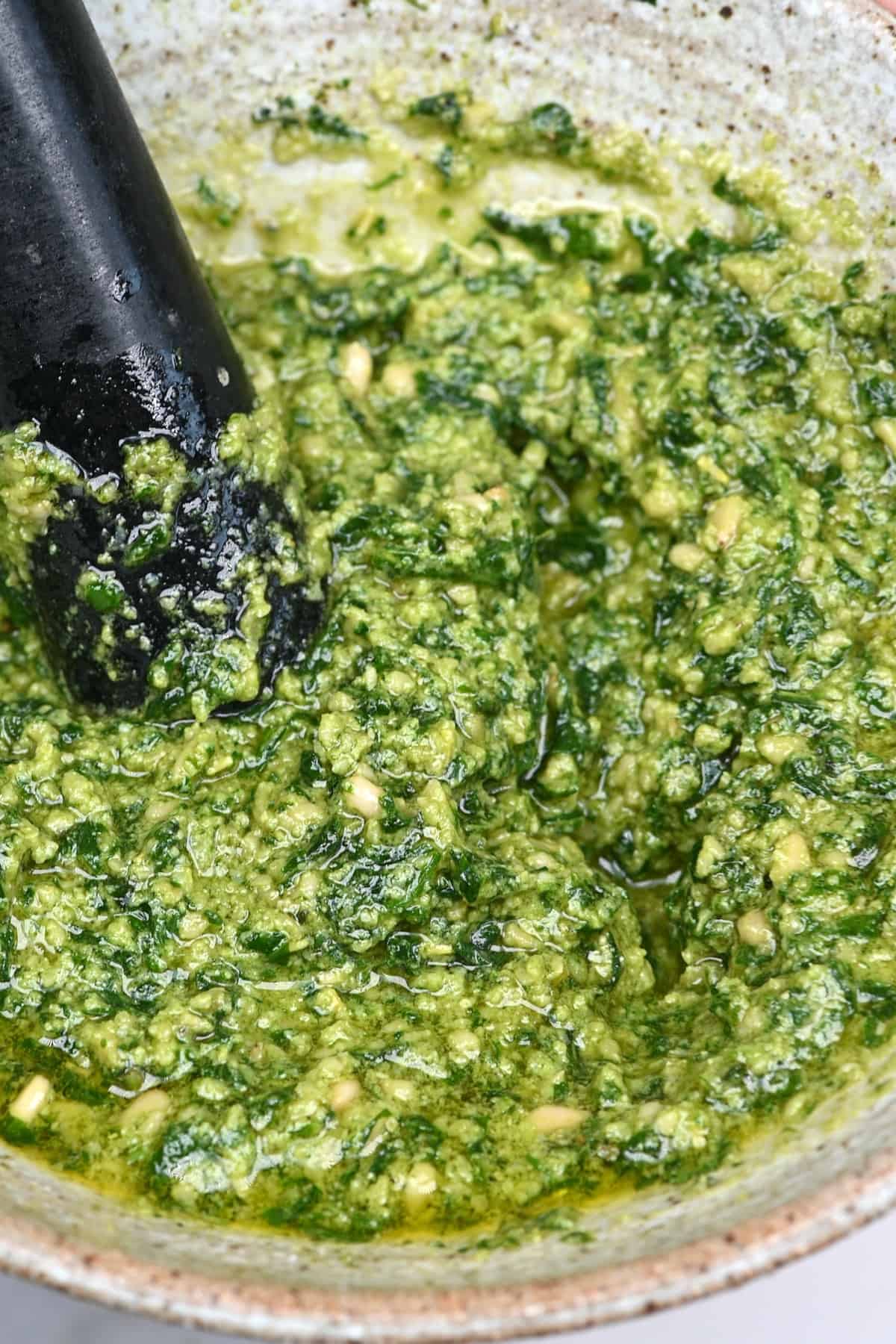
Recently I’ve loved sharing recipes that rely on just a few simple ingredients, like Mexican salsa Roja and Salsa Verde, and burrata Caprese salad. Now it’s the turn of this pesto alle Genovese.
With a simple combination of fresh, just-picked basil, high-quality salty, savory parmesan and pecorino cheese, creamy pine nuts, rich extra virgin olive oil, and garlic and salt (the “cherry on top”) – this simple, fresh pesto is everything and more!
While the traditional Genovese pesto is extremely specific on the origin of the ingredients used in the pesto, I’ve done my best to stick to the classic recipe with what’s available to me here in the UK – with a few non-traditional optional ingredients mentioned below.
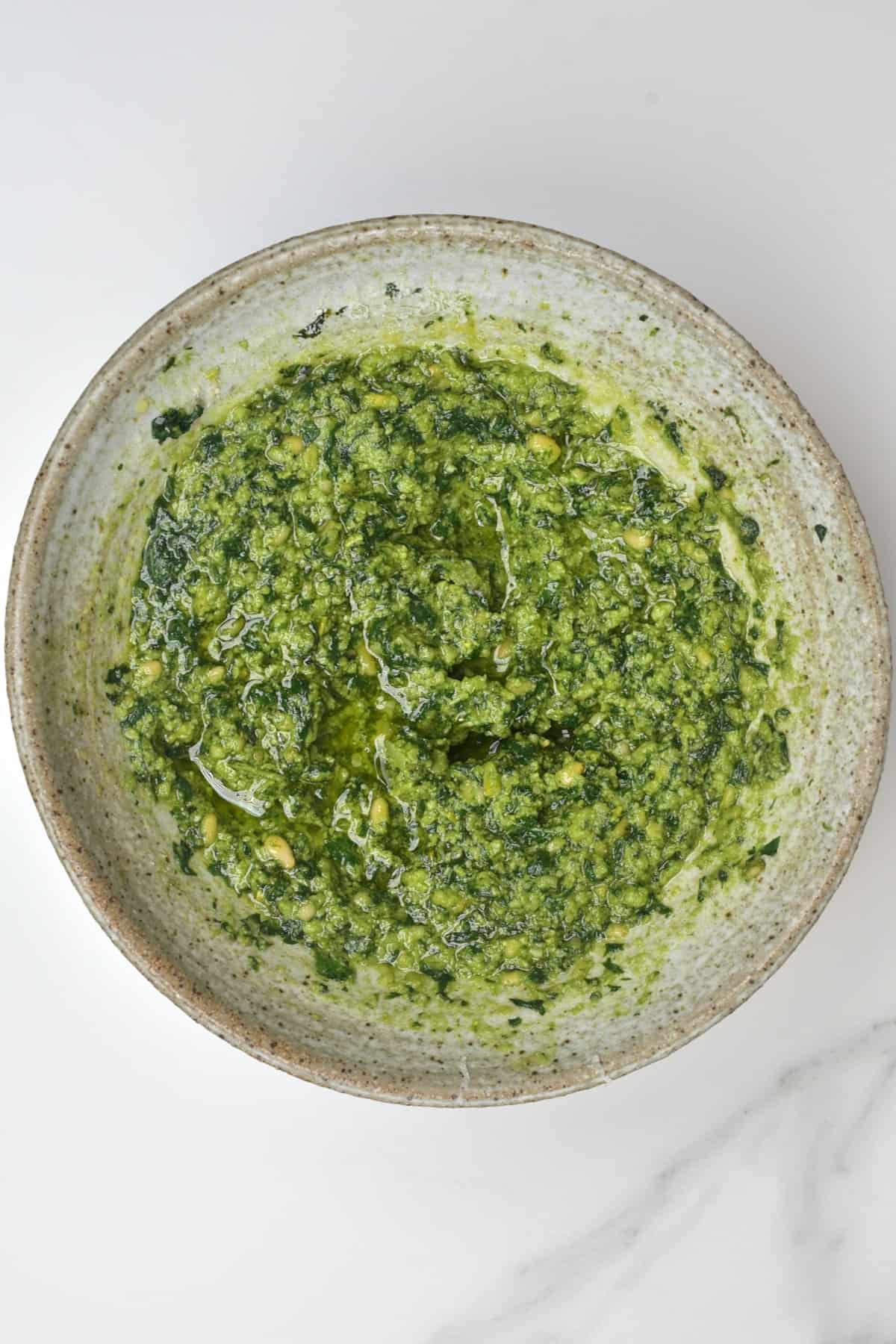
If you have a basil plant, this homemade basil pesto is practically a right of passage. If you don’t, pick one up (or at least some freshly on-the-day picked basil leaves) and get to it.
Best of all, the simple, fresh flavors in this pesto Genovese are unlike any grocery store pesto you’ve ever had before!
Want to save this recipe?
The Basil Pesto Ingredients
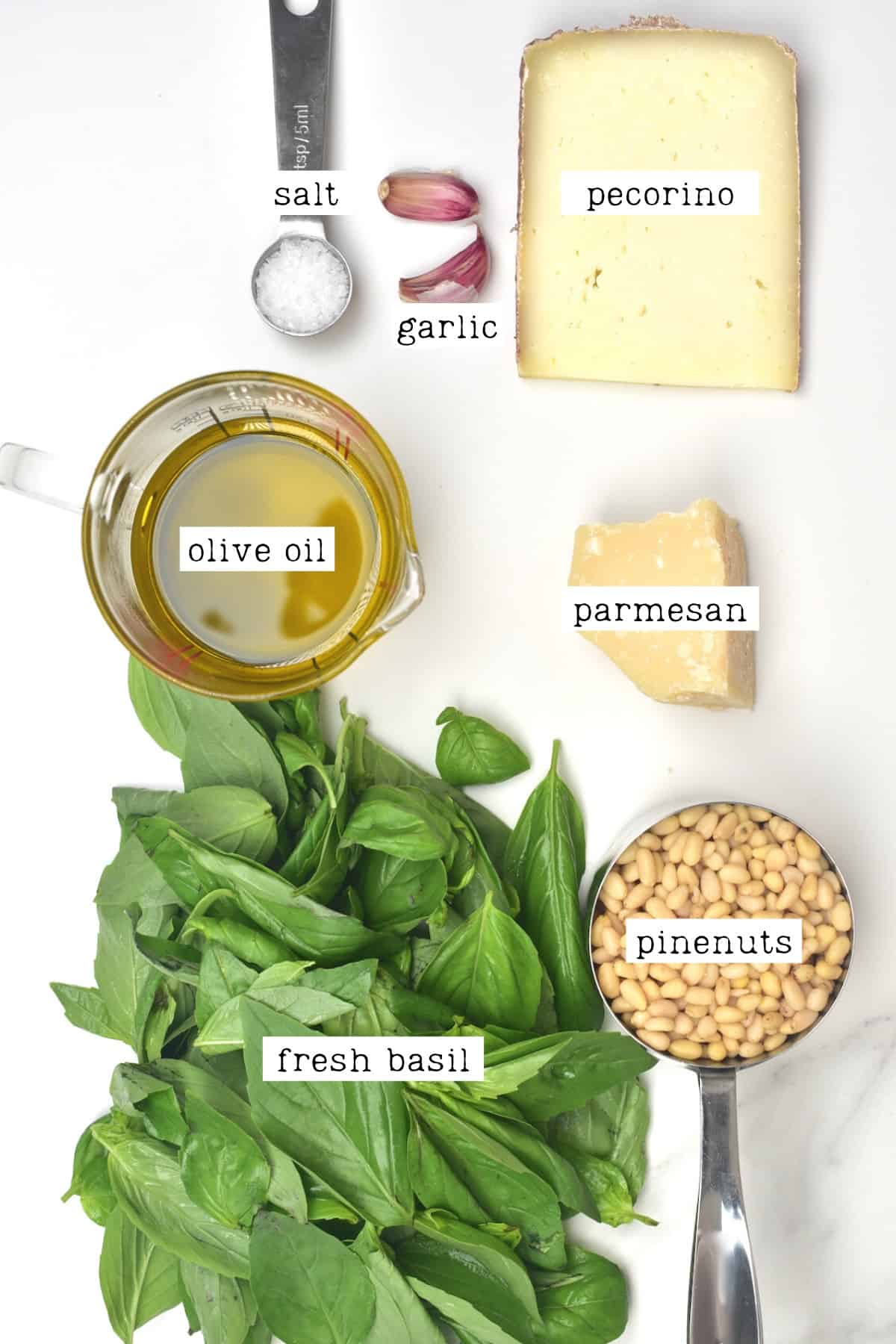
- Basil: if you can, I recommend picking it from the plant right before making this homemade basil pesto for the freshest results – rinse and pat them dry. You could also use a combination of basil and spinach. You could also swap out the basil entirely for other herbs like cilantro and mint – but that honestly makes another recipe entirely.
- Extra virgin olive oil: use high-quality olive oil for the best flavor and mouthfeel. I always keep a bottle of high-quality extra virgin olive oil specifically for raw recipes like this fresh pesto.
- Cheese: I used a combination of pecorino and Parmigiano-Reggiano – though you could use just pecorino. Note: not all parmesan is vegetarian-friendly due to the use of animal rennet.
- Pine nuts: if you don’t have pine nuts, you could use cashews, walnuts, almonds, or even pistachios. However, pine nuts are the traditional choice and have an amazing buttery flavor. You can enjoy them raw or lightly toasted.
Other add-ins and variations
- Lemon juice: adding a little squeeze of lemon juice is 100% optional but adds a lovely “brightness”. It may also help preserve the green color of the basil for longer.
- Red pepper flakes: for a bit of heat, you could add a pinch of red pepper flakes to the homemade pesto.
- Sun-dried tomato: I’ll often add some of my “sun-dried” tomatoes when making this pesto Genovese for pasta dishes.
- To thin the pesto sauce: a little splash of cold water or milk could be added for a thinner, creamier pesto sauce.
- Dairy–free basil pesto: use a vegan parmesan, some nutritional yeast, or omit the cheese entirely.
How to Make Pesto Alle Genovese
Step 1: Prepare the basil leaves
This may not always be required depending on where you source your basil. However, I like to begin by cleaning my basil leaves and patting them dry.
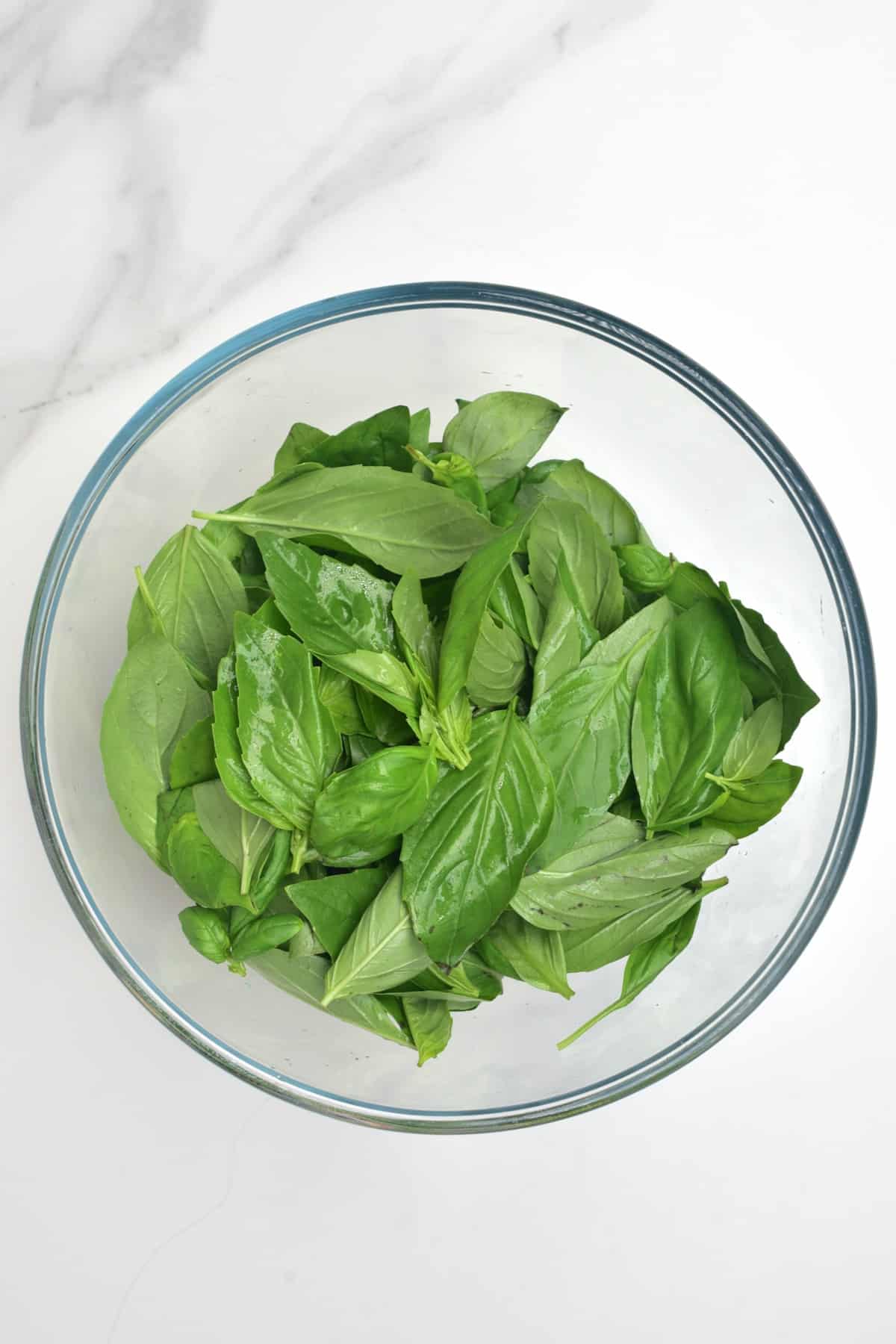
Step 2: Grind the ingredients
First, add the garlic and salt to your mortar. Use the pestle in circular motions to grind it into a thick paste-like consistency.
Then add the basil leaves in increments, and make sure to grind in a circular motion around the mortar walls to break up the leaves without just smashing them into pieces. Do this until all the basil has been added.
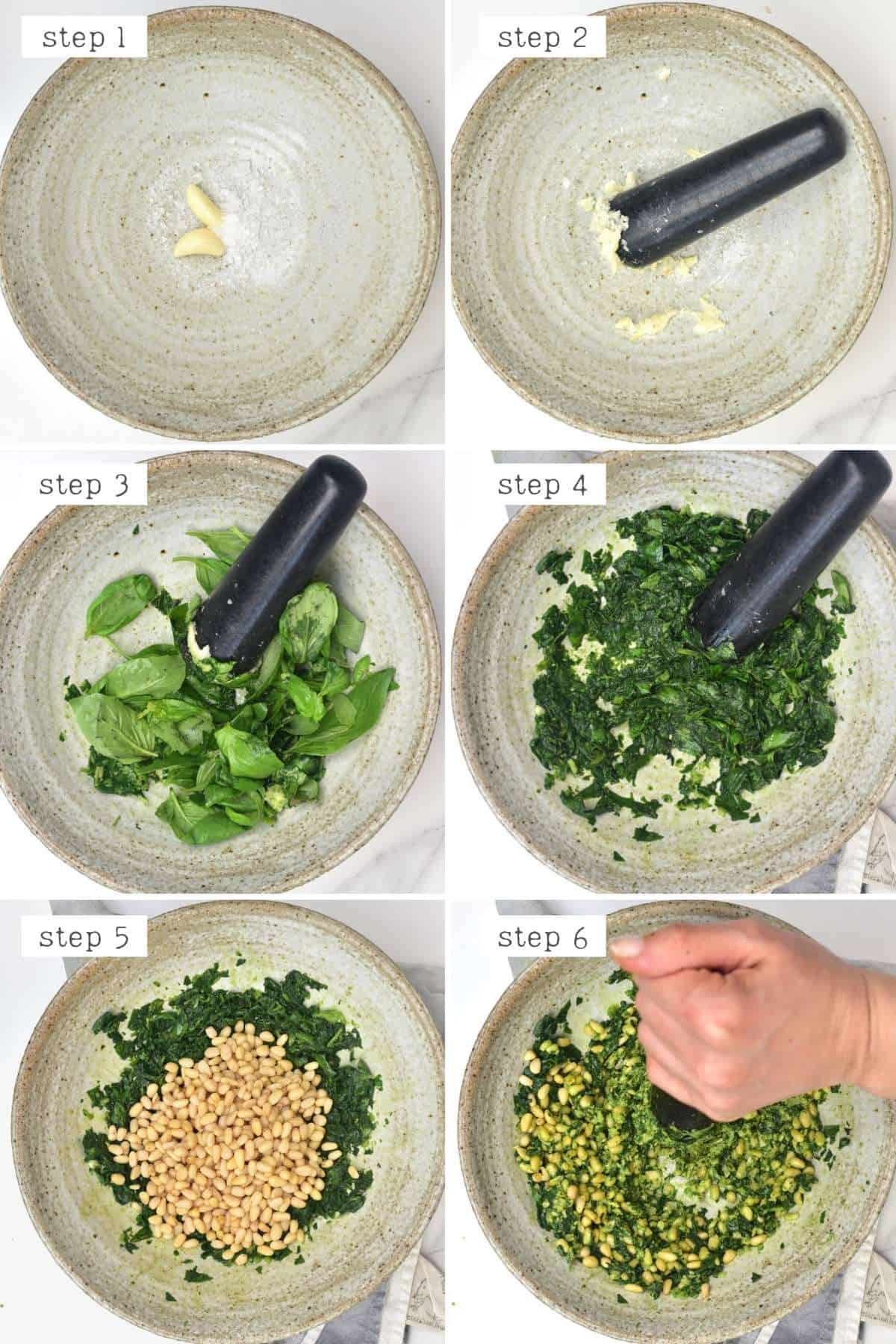
Then add the pine nuts, grinding in-between, before adding the finely grated cheese.
Finally, start to add the olive oil. Do this just a little bit at a time, grinding in-between, for a silky pesto.
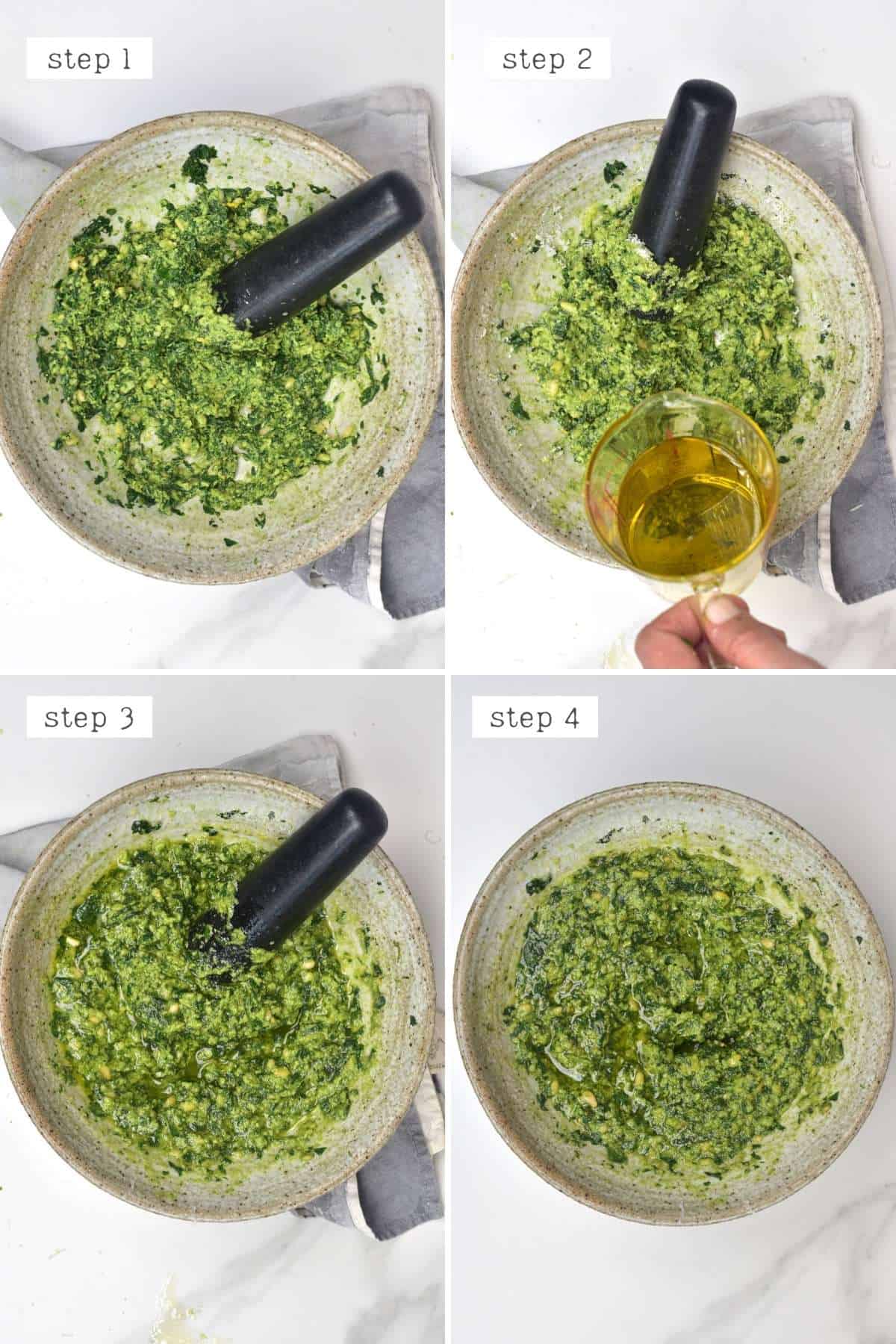
To make basil pesto in a food processor
- Lightly pulse the garlic, pine nuts, and basil until finely chopped (but not pureed).
- Slowly drizzle in olive oil as the machine runs.
- Finally, add the cheese and pulse a few times to thoroughly combine all the ingredients.
If your food processor doesn’t have a spout, you can simply add olive oil a little bit at a time and blend for a few seconds in-between each addition.
When using a food processor/blender, try not to allow the machine to run for too long and heat the pesto. It can negatively impact the quality of the Genovese pesto.
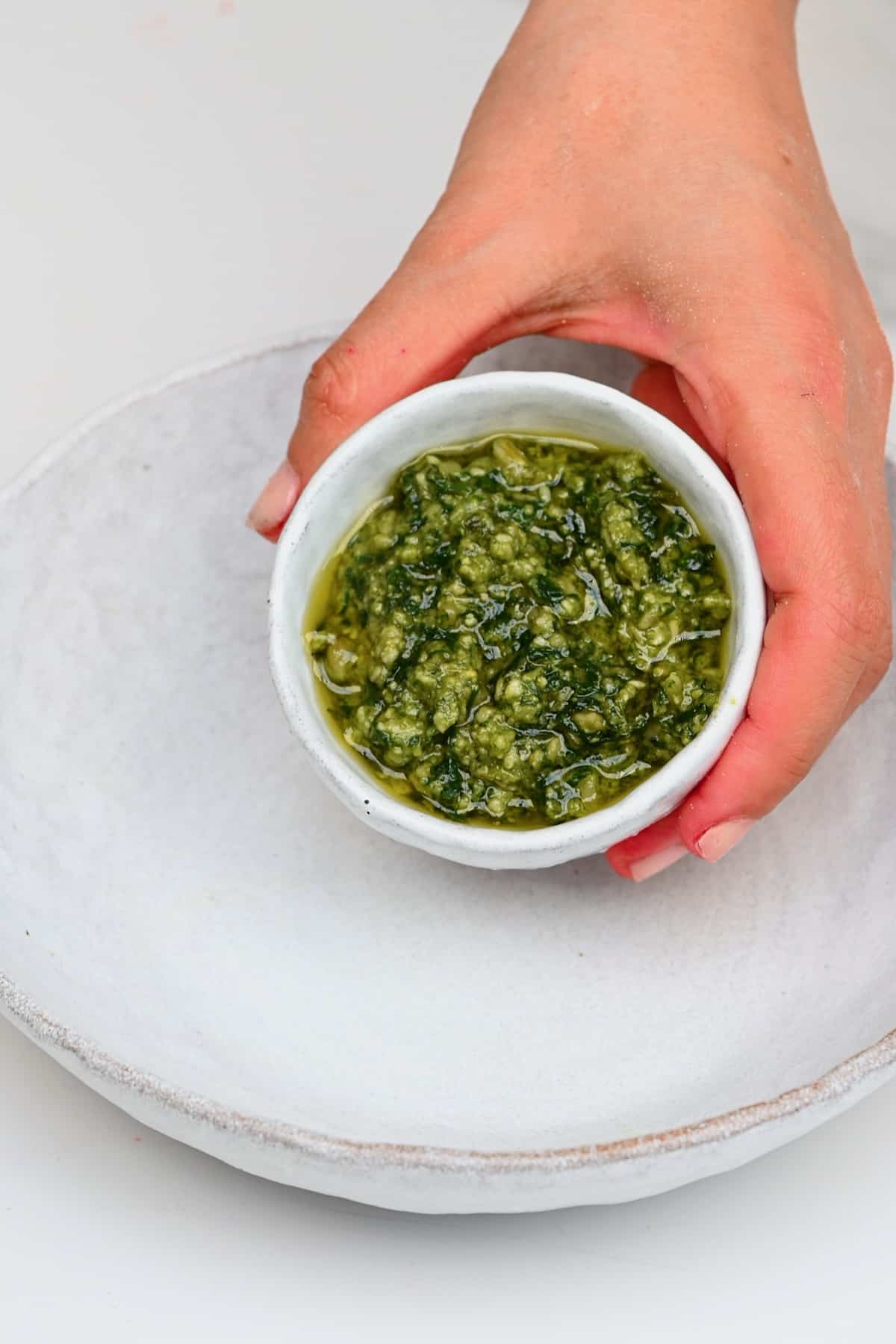
How to Use
There are tons of ways you can enjoy this homemade pesto, including:
- With pasta: Whether it’s a cold pasta salad or hot pasta dish (like mixed into mac n’ cheese, with ravioli, or homemade spinach pasta). Plus, with zoodles too!
- With salads: Like homemade potato salad, egg salad, etc.
- Pesto Avvantaggiato: A pesto Genovese pasta dish served with either trenette or trofie pasta, potatoes, and green beans.
- With bread: Spread over bread (like bruschetta) or for dipping. It also makes for a delicious addition to sandwiches and grilled cheese.
- Wraps/Tortilla: Like this eggplant halloumi wrap or as part of a quesadilla using the tortilla trend.
- Caprese salad: a little drizzle of Caprese salad (or burrata caprese) is delicious.
- Over roasted veggies: Like roasted potatoes, green beans, asparagus, etc.
- As a pizza topping: Like for this butternut squash pesto pizza, Neapolitan pizza, or zucchini pizza bites.
- To garnish dips: Like homemade hummus, white bean dip, or labneh.
How to Store?
Store: once prepared, the homemade basil pesto can be stored in the refrigerator for between 7-10 days.
Basil pesto will darken the longer it’s exposed to oxygen, so it’s best to store in a similar way to guacamole; in an airtight container with a layer of plastic across the top of the pesto or a tiny layer of oil to minimize the air contact.
Freeze: freezing pesto is simple. I recommend freezing the homemade basil pesto in a silicone ice-cube tray to portion it. Then transfer to a freezer-safe bag for up to 6 months for the best results (though I’ve enjoyed some a year later at one point that was still delicious!). Then you can simply defrost as much as is needed and enjoy!
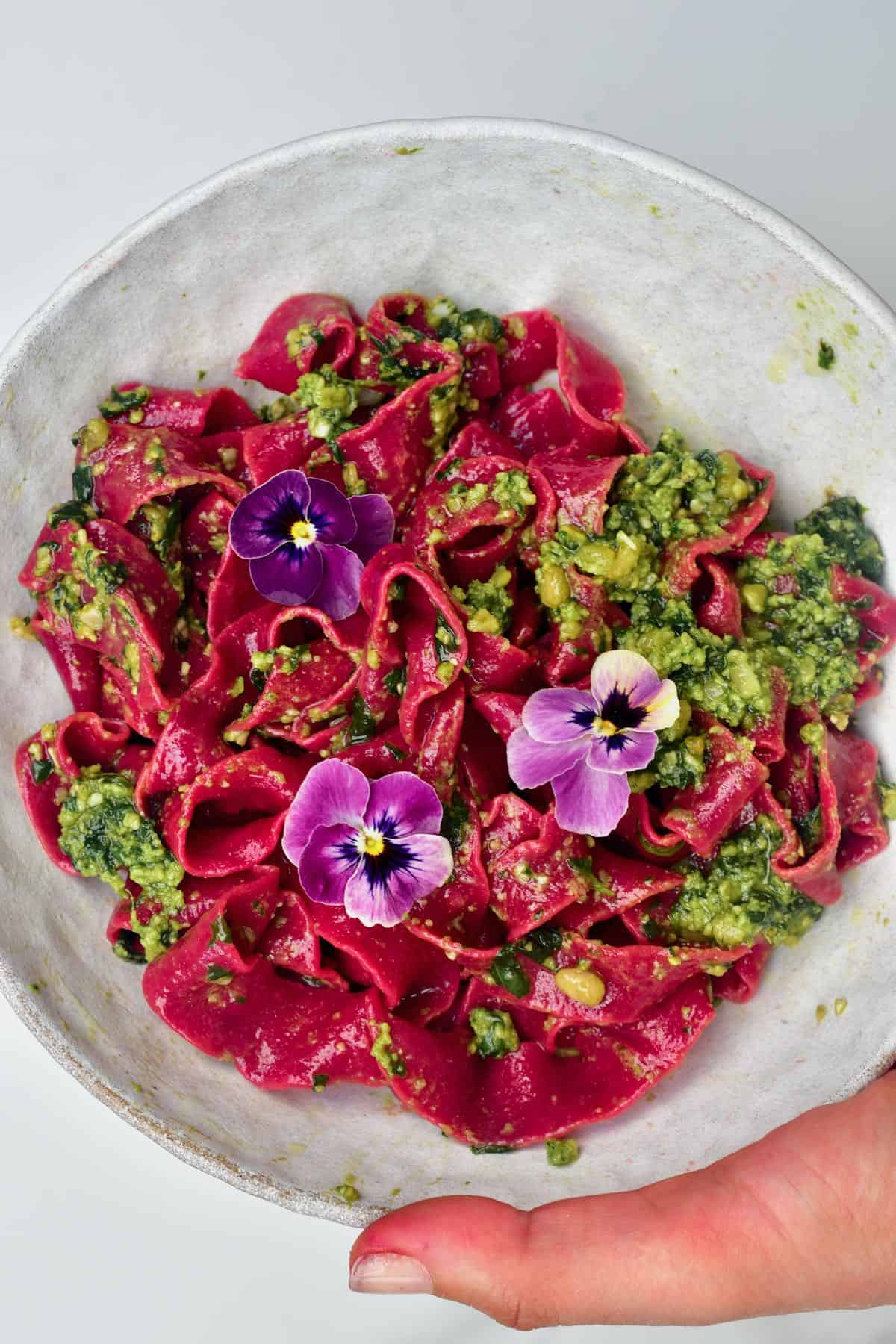
FAQs
You can substitute the nuts in this basil pesto recipe for sunflower seeds, hemp seeds, or pumpkin seeds, though I haven’t tried this, so I don’t know how much the flavor differs for a pesto without nuts.
While using a mortar and pestle may make the process take longer (with more arm muscle needed), this method is preferred by many. A mortar and pestle tend to not oxidize or heat the basil as much as using food processor blades – for a greener, fresher, less bitter pesto. Not to mention, the texture of home-ground pesto is slightly chunkier and easier to keep that way.
Similar to how avocados (and guacamole!) react once oxidized, basil has a similar kind of reaction and darkens when exposed to oxygen.
To avoid the basil pesto darkening, you could blanch the basil leaves in boiling water for just a few seconds, then add to ice water and dry them before creating the basil pesto.
Placing your food processor “blade” in the fridge for 10-15 minutes can also help to keep the green pesto for longer.
Recipe Notes and FAQs
- Adjust the amount of garlic: As with all recipes that include garlic, the amounts come down to personal taste. I love garlic (I mean, have you seen my toum recipe?!) so feel free to adjust the amount. I recommend adding half to begin and increasing to taste.
- Where to find basil: If you aren’t growing your own, it can seem a little pricey from the supermarket. For the most cost-effective options, I recommend buying it from farmer’s markets. Alternatively, purchase the basil clamshell packages from the supermarket, which are often fresher and more cost-efficient.
- Using frozen basil: If you grow your own basil, you may have had times where you’ve frozen excess basil leaves. It’s perfectly fine to thaw these out and use them for basil!
- When serving with pasta: I recommend saving some of the starchy pasta water to help the pesto adhere to the pasta better. Here’s how to cook pasta if you want a quick guide to get the texture just right.
More Easy Fresh Sauce Recipes
- Sun-Dried Tomato Pesto (Pesto Rosso | Red Pesto)
- Quick gyoza sauce
- Greek tzatziki (gyro sauce)
- Homemade chili sauce
- Lebanese garlic sauce
- Lemon herb tahini sauce
- Creamy avocado cilantro sauce
- Peanut dipping sauce
- Fresh Basil Hummus (5 Ingredients | Pesto Hummus)
If you try this homemade basil pesto recipe (pesto alle genovese), I’d love to hear your thoughts/questions below. Also, I’d appreciate a recipe card rating below, and feel free to tag me in your recipe recreations on Instagram @Alphafoodie!
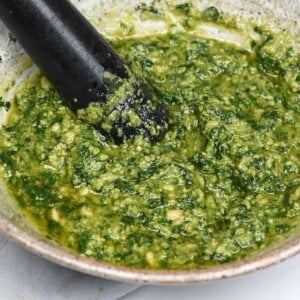
Homemade Basil Pesto (Pesto Alle Genovese)
Ingredients
- 2.5 oz basil or a combination of basil and spinach
- 1.8 oz pine nuts or walnut, almond, pistachio cashew. Nut free = sunflower seeds, hemp seeds, or pumpkin seeds
- 5 floz extra virgin olive oil
- 1 tsp salt
- 2 garlic cloves adjust to personal preference (roasted or raw)
- 2.5 oz Pecorino cheese check notes for vegan option
- 1 oz parmesan cheese
Instructions
Step 1: Prepare the basil leaves
- This may not always be required depending on where you source your basil. However, I like to begin by cleaning my basil leaves and patting them dry.
Step 2: Grind the ingredients
- Add the garlic and salt to your mortar and use the pestle in circular motions to grind it into a thick paste-like consistency.
- Add the basil leaves in increments, and make sure to grind in a circular motion around the mortar walls to break up the leaves without just smashing them into pieces. Do this until all the basil has been added.
- Add the pine nuts, grinding in-between, before adding the finely grated cheese.
- Add the olive oil. Do this just a little bit at a time, grinding in-between, for a silky pesto.
To make basil pesto in a food processor:
- Lightly pulse the garlic, pine nuts, and basil until finely chopped (but not pureed).Slowly drizzle in olive oil as the machine runs.If your food processor doesn’t have a spout, you can simply add olive oil a little bit at a time and blend for a few seconds in-between each addition.Finally, add the cheese and pulse a few times to thoroughly combine all the ingredients.When using a food processor/blender, try not to allow the machine to run for too long and heat up the pesto, or it can negatively impact the quality of the Genovese pesto.
Video
Notes
- Lemon juice: Adding a little squeeze of lemon juice is 100% optional but adds a lovely ‘brightness’ for those who love lemon. It may also help preserve the green color of the bail for longer.
- Red pepper flakes: For a bit of heat, you could add a pinch (or more) of red pepper flakes to the homemade pesto.
- Sun-dried tomato: I’ll often add some of my ‘sun-dried’ tomatoes when making this pesto Genovese specifically for pasta as I love the additional flavor the tomatoes provide.
- To thin the pesto sauce: A little splash of cold water or milk could be added if you want a thinner, creamier pesto sauce.
- Dairy–free basil pesto: You could use a vegan parmesan, some nutritional yeast, or omit the cheese entirely for a dairy-free option.
Recipe Notes:
- Adjust the amount of garlic: As with all recipes that include garlic, the amounts come down to personal taste. I love garlic (I mean, have you seen my toum recipe?!) so feel free to adjust the amount to personal preference. I recommend adding half to begin and increasing to taste.
- Where to find basil: If you aren’t growing your own, it can seem a little pricey to pick up fresh basil from the supermarket. For the most cost-effective options, I recommend buying it from farmer’s markets or purchase the basil clamshell packages from the supermarket, which are often fresher and more cost-efficient.
- Using frozen basil: If you grow your own basil, you may have had times where you’ve frozen excess basil leaves. It’s perfectly fine to thaw these out and use them for basil!
- When serving with pasta: I recommend saving some of the starchy pasta water to help the pesto adhere to the pasta better.
Read the blog post for more ingredient notes and answers to top FAQs.
Nutrition
Nutrition information is automatically calculated, so should only be used as an approximation.

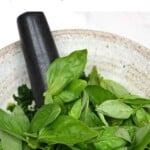
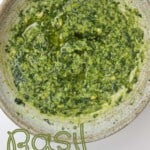
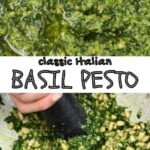
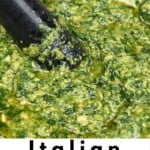
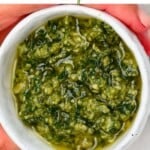
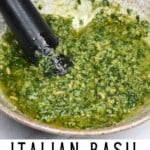









This was the most delicious pesto I have ever had! I could eat it on everything. I stored it in the refrigerator and when I heated it in the microwave the cheese clumped together and was difficult to separate. But still delicious. Do you have a suggestion?
Hi Christine,
Thank you, glad you like it. Perhaps you can try adding it after you warmed up a dish and avoid heating it up in the microwave. I hope this helps.
Hi! I love this handmade basil pesto recipe! Thank you for posting it! By the way, where did you get that beautiful mortar and pestle?
Thank you for your comment, Gabrielle.
I found it at charity shop.